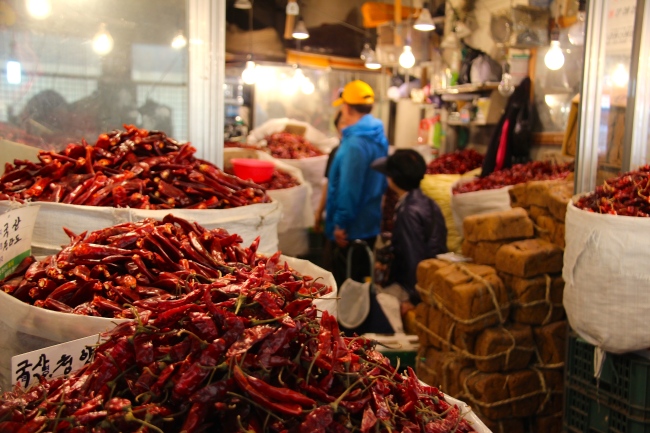Although Dongdaemun and Namdaemun tend to dominate many lists of “must-see markets” in Seoul, small-scale markets that are equally full of history and character are scattered across the city. This is the fifth installment of a series introducing traditional local markets. ― Ed.
If strolling up and down the aisle mazes of giant conglomerate shopping malls with marked-up prices and pushing around shopping carts is not your cup of tea, it’s safe to assume that you will be pleased with the Gyeongdong Market which offers customers the same goods in a wildly contrasting, yet pleasantly more thrilling old-time atmosphere.
Sandwiched between the Yangnyeong Market and the Chungryangri Market, this tri-part traditional market area located in Jegi-dong is largely overlooked or unknown to nonlocals, being only minutes away from the glitz of the Dongdaemun Market.
 |
A scene from the Gyeongdong Market, located in Seoul’s Dongdaemun District in Jegi-dong. (Julie Jackson/The Korea Herald) |
“We are not like Dongdaemun or Namdaemun or those other really famous markets, because unlike our market, they have become big-time tourist attractions more than anything. And honestly, that makes it less appealing for us Koreans to visit,” said a Gyeongdong Market vendor.
“Gyeongdong Market is solely focused on the locals in this area,” he continued. “And although we do get the occasional tourists who stroll through here, for the most part, this is where people who live in this neighborhood come for their bargain shopping.”
Despite not being a heavily marketed tourist attraction, visitors should not make the mistake of concluding that it is a small, quaint market area ― which I admit was my initial faulty assumption. But in fact, the massive size and seemingly endless labyrinth of food street stalls and fork-in-the-road alleyways at every turn is what took me by surprise the most. I almost wished I had a map to get reassured that I didn’t miss all that the market had to offer ― from hanging dried fish heads, whole squid, to edible tree bark or a simple bundle of bananas.
“I think most foreigners who visited the market didn’t realize how big it really is, since it is seen as one of the lesser known traditional markets in Seoul,” said one fruit vendor.
The market has a long-standing history in the city. Following the tragic aftermath of the Korean War, local famers used to gather in the area to sell-off their produce, slowly leading to the establishment of the Gyeongdong Market in 1960. Today, it is best known as one of the nation’s largest suppliers of oriental medicine ingredients.
“Because of the history of this market, we are mostly known for our herbal medicines,” said one of the market’s traditional herbs sellers. “These herbs are part of Korean traditional practices that our people have been using for centuries before the invention of modern medicine. So many locals still come here looking for organic solutions to help cure whatever ailments they are suffering from.”
“But over the years the Gyeongdong Market has grown far beyond this,” he continued. “It’s more than just a place for herbal medicine. It doesn’t matter if it’s herbs, exotic seafood like live eels or even something as generic as apples or grapes, you can find it fresh right here at very reasonable prices that you can’t find at those big chain stores.”
If you go:
The Gyeongdong Market is located in Jegi-dong, Dongdaemun-gu, just a short walk from Jegi-dong Station (Subway Line 1), exit 2. The market is open daily from 4 a.m.-7 p.m. However, hours may vary depending on certain shop owners.
By Julie Jackson (
juliejackson@heraldcorp.com)








